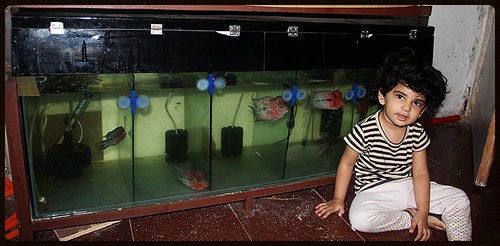
Nerjis Asif Shakirs Unique Rare Flowerhorn Collection, a photo by firoze shakir photographerno1 on Flickr.
Flowerhorn cichlids are ornamental aquarium fish noted for their vivid colors and the distinctively shaped heads for which they are named. Their head protuberance, or kok, is formally termed a "nuchal hump." Like blood parrot cichlids, they are man-made hybrids that do not exist in nature. First developed in Malaysia, Thailand, and Taiwan, they are now kept by fish hobbyists worldwide. Some critics have questioned the impact of flowerhorn breeding programs.
Origin[edit]
Flowerhorn breeding dates from 1993.[1] Malaysians admired fish with protruding heads, known as Karoi or "warships," found in the western part of the nation. The slightly protruding forehead and long tail of these fish were prized in Taiwanese society as bringing luck in geomancy. By 1994, red devil cichlids (typically Amphilophus labiatus) and trimac cichlids (Amphilophus trimaculatus) had been imported from Central America to Malaysia and the hybrid blood parrot cichlid had been imported from Taiwan to Malaysia and bred these fish together, marking the birth of the flowerhorn.[dubious – discuss]
In 1995, the blood parrots were further crossbred with the Human Face Red God of Fortune, which produced a new breed called the Five-Colors God of Fortune.[1] With its beautiful colors, this fish quickly became popular. Selective breeding continued through 1998, when the Seven-Colors Blue Fiery Mouth (also known as Greenish Gold Tiger) was imported from Central America, and crossbred with the Jin Gang Blood Parrot from Taiwan.[1] This crossbreeding led to the first generation of Hua Luo Han flowerhorn hybrids, which were then followed by subsequent flowerhorn introductions.
Arrival in the West[edit]
When Luo Hans were first imported to the United States, there were only two breeds of these fish for distribution, flowerhorn and golden base.[1] Flowerhorns came in two varieties, those with pearls (silver-white spots on the skin) and those without. Golden bases also had two varieties, those that faded and those that did not. Among the flowerhorns, the ones without pearls were quickly overtaken in popularity by those with pearls, becoming pearl scale flowerhorns, or Zhen Zhu. With the golden bases, the unfaded ones developed an attractive golden skin in place of what had been the flowerhorn’s grey skin.
As of 1999, there were four strains of flowerhorn available in the American market: regular flowerhorns, pearl scale flowerhorns, golden flowerhorns, and faders.[1] Commercial breeders proliferated, and fish were selected for appearance with little regard for terminology.[1] Consequently, names became confusing and parentage became difficult to track.
Around 2000–2001, the Kamfa variety appeared. These were hybrids of any type of flowerhorn crossed with any species of the genus Vieja or with any parrot cichlid.[1] These brought in some new traits, such as short mouths, wrapped tails, sunken eyes, and increasingly larger head bumps. Seeing this, those who bred the Zhen Zhus began line breeding their fish to develop faster and become more colorful, in order to compete with the Kamfa strains.[1]
Care[edit]
Flowerhorn cichlids have a life span of 10–12 years. They are usually kept at a water temperature of 80–85 °F, and a pH of 7.4–8.0. They require a tank of a minimum of 55 gallons, with 125 gallons optimal. A breeding pair may require a tank of 150 gallons or more, depending on size. Being aggressive and territorial, two or more flowerhorns are usually not kept together, but the tank housing them can be divided up with acrylic dividers or egg crates.
There are several ways by which breeders distinguish between male and female flowerhorns. Generally, the males are larger than the females, but there are some exceptions. Males have the kok, or the nuchal hump, on their foreheads. Males also usually have brighter and more vivid colors. For most breeds, the females have black dots on their dorsal fins, whereas males usually have longer anal and dorsal fins. Females tend to have an orange belly, especially when ready to breed. The mouth of the male is thicker and more pronounced than the female's.
Flowerhorn cichlids are subject to several diseases, including hole-in-head disease, "ich", and digestive blockages.
Golden Monkey[edit]
Golden Monkey
The genuine Golden Monkey (also called Good Fortune) or Kamalau was bred by Mr. Lam Seah and Lam Soon in Bercham, Ipoh, Malaysia. After the third generation, all of them were sold to the A-1 Aquarium in 2001. This type of flowerhorn is an original Luohan-based fish and not a mixed type Zen Zhu or Kamfa.[1]
It can be a particularly expensive flowerhorn, carrying a price tag of more than one thousand dollars. The most expensive Golden Monkey was sold for 600-thousand dollars during a Malaysian exhibition in 2009.[citation needed]
Kamfa[edit]
Kamfa
This breed originated from the Luohan. Its main characteristics are white or yellow eyes (red eyes are possible but not common), a fan tail, a water-colored head bump, sunken eyes, and smaller lips than the Zhen Zhu. This breed generally also has a larger and more square body than that of the Zhen Zhu. Head flowers can be found on the Kamfa, but not as prominently as with Zhen Zhus.
more at
en.wikipedia.org/wiki/Flowerhorn_cichlid

